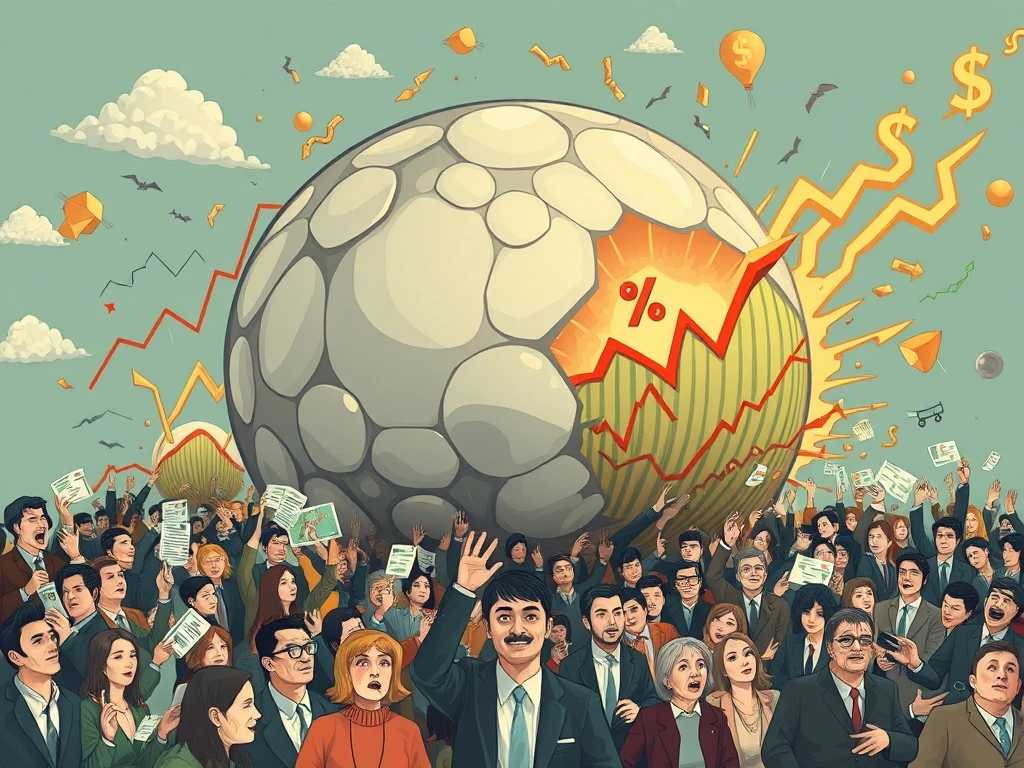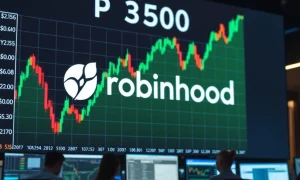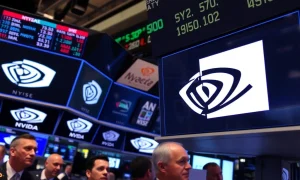Are you feeling a mix of fear of missing out (FOMO), envy, or even greed as stock markets reach unprecedented highs? You are certainly not alone. Many investors experience these powerful emotions during periods of rapid market ascent. These feelings, in fact, often serve as key ingredients in the formation of market bubbles. Understanding these dynamics is crucial for any investor navigating today’s complex financial landscape.
What Are Market Bubbles?
A market bubble occurs when asset prices rise rapidly and significantly. This increase is often detached from the underlying intrinsic value of those assets. Furthermore, it is driven primarily by speculative demand. Prices inflate due to investor enthusiasm rather than fundamental improvements. Eventually, the bubble bursts, leading to a sharp decline in prices. This can cause substantial financial losses for many.
Economists and financial analysts identify several distinct phases in the life cycle of market bubbles:
- Displacement: A new paradigm emerges, like a technological innovation or a change in financial policy.
- Boom: Prices rise slowly at first, then accelerate as more investors enter the market.
- Euphoria: Speculation dominates. New investors jump in, often driven by FOMO. Prices become highly inflated.
- Profit-Taking: Savvy investors begin selling their holdings, realizing gains.
- Panic: Prices drop sharply as fear replaces greed. Everyone tries to sell, leading to a market crash.
Historically, market bubbles have occurred across various asset classes. They represent a recurring pattern in financial history. Understanding these patterns helps investors prepare.
The Psychology Behind Market Bubbles: FOMO, Envy, and Greed
Human psychology plays a profound role in the creation and expansion of market bubbles. Emotional biases often override rational decision-making. This leads to widespread speculative behavior.
Fear of Missing Out (FOMO)
FOMO is a powerful driver in rising markets. Investors see others making significant gains. Consequently, they fear being left behind. This anxiety pushes them into the market, even at inflated prices. They might ignore fundamental analysis. Instead, they chase quick profits. This influx of capital further inflates asset values. Ultimately, it fuels the bubble’s growth.
Envy
Envy also contributes to speculative fervor. People observe friends, family, or even strangers achieving financial success. This can lead to feelings of inadequacy. As a result, they desire similar outcomes. This desire often translates into reckless investment decisions. They might invest in assets they do not fully understand. Their primary motivation is to replicate others’ gains.
Greed
Greed, perhaps the most potent emotion, drives irrational exuberance. As prices continue to climb, investors become fixated on potential future gains. They may abandon caution. Risk tolerance increases significantly. The belief that ‘this time is different’ becomes pervasive. Investors take on excessive leverage. They pour more money into speculative assets. This insatiable desire for more profit accelerates the bubble’s expansion. Eventually, it reaches unsustainable levels.
These psychological factors combine to create a herd mentality. Investors follow the crowd. They often disregard warning signs. This collective behavior amplifies market trends. It pushes prices far beyond their intrinsic value. Ultimately, it sets the stage for an inevitable correction.
Identifying Signs of an Impending Market Bubble
Recognizing the signs of a developing market bubble is crucial for investors. Early identification allows for proactive risk management. Here are key indicators to watch:
- Rapid Price Increases: Asset prices surge without corresponding increases in earnings or value. This acceleration is often exponential.
- Speculative Investing: Investors buy assets purely based on the expectation of selling them at a higher price. They pay little attention to fundamentals.
- New Investor Participation: Many inexperienced investors enter the market. They are often drawn by headlines of quick wealth.
- Detachment from Fundamentals: Valuations become extremely high. Traditional metrics like Price-to-Earnings (P/E) ratios lose relevance.
- Widespread Optimism: Media coverage is overwhelmingly positive. Skeptics are dismissed or ridiculed.
- Increased Leverage: Investors borrow heavily to buy assets. This amplifies both gains and potential losses.
- Euphoric Public Sentiment: Everyone, from taxi drivers to barbers, discusses their stock market successes.
While these signs suggest a bubble, predicting its exact bursting point remains impossible. However, awareness allows for better preparedness. Investors can adjust their strategies accordingly. They can protect their portfolios from severe downturns.
Navigating Record Stock Prices and Avoiding Market Bubble Traps
When stock prices reach record highs, it can be tempting to get swept up in the excitement. However, a prudent approach is essential to avoid the pitfalls of potential market bubbles. Investors must prioritize long-term stability over short-term gains.
Consider these strategies:
- Diversification: Spread your investments across different asset classes. Include stocks, bonds, real estate, and commodities. This reduces risk if one sector experiences a downturn.
- Long-Term Perspective: Focus on your long-term financial goals. Avoid making impulsive decisions based on daily market fluctuations. Short-term speculation is risky.
- Due Diligence: Research any investment thoroughly. Understand the underlying business and its fundamentals. Do not invest in something just because its price is rising.
- Risk Management: Set clear risk limits. Use stop-loss orders. Avoid over-leveraging your portfolio. Only invest what you can afford to lose.
- Emotional Discipline: Resist the urge to follow the crowd. Stick to your investment plan. Do not let FOMO or greed dictate your actions. Maintain a rational mindset.
- Rebalancing: Periodically adjust your portfolio. Sell assets that have become overweighted. Reinvest in underperforming but fundamentally sound assets.
By adopting these disciplined approaches, investors can navigate periods of high market valuations more safely. They can protect their capital from the eventual bursting of market bubbles. Furthermore, they can position themselves for sustained growth.
Historical Lessons from Past Market Bubbles
History offers valuable insights into the nature and consequences of market bubbles. Examining past episodes reveals common patterns and important lessons for investors today. These events highlight the dangers of irrational exuberance.
- Tulip Mania (1630s): This is one of the earliest recorded speculative bubbles. Tulip bulb prices in the Netherlands soared to astronomical levels. Some rare bulbs traded for more than houses. The bubble eventually burst, leading to widespread financial ruin for many.
- South Sea Bubble (1720): A British company, the South Sea Company, promised massive returns from trade with South America. Its stock price skyrocketed. However, the company’s business was largely fraudulent. The bubble collapsed, causing a severe economic crisis in Britain.
- Dot-com Bubble (Late 1990s): The rise of the internet fueled massive speculation in technology stocks. Many internet companies with no profits or viable business models saw their valuations soar. The bubble burst in 2000, leading to a significant market correction and recession.
- U.S. Housing Bubble (Mid-2000s): Loose lending standards and widespread speculation in real estate led to rapidly inflating housing prices. Subprime mortgages fueled the boom. The bubble burst in 2007-2008, triggering the global financial crisis.
These historical events share common threads. They involve new technologies or financial innovations. They are characterized by periods of intense speculation. They are driven by public enthusiasm. Crucially, they all end in a sharp, painful correction. The lesson is clear: excessive optimism and a disregard for fundamental value inevitably lead to unsustainable outcomes.
Conclusion
The current environment of record stock prices naturally evokes strong emotions like FOMO, envy, and greed. However, understanding how these feelings contribute to the formation of market bubbles is vital. Historical precedent clearly demonstrates the cyclical nature of market booms and busts. By recognizing the signs of speculative excess and practicing sound investment principles, you can better protect your financial future. Always prioritize rational decision-making over emotional impulses. Stay informed, remain diversified, and maintain a long-term perspective. These actions will help you navigate volatile markets effectively.
Frequently Asked Questions (FAQs)
What is a market bubble?
A market bubble is a rapid and significant increase in asset prices, often detached from their fundamental value, driven by speculative demand and investor enthusiasm, eventually leading to a sharp decline.
How do FOMO, envy, and greed contribute to market bubbles?
These emotions drive irrational behavior. FOMO makes investors buy into rising markets to avoid missing gains. Envy fuels the desire to replicate others’ success. Greed pushes investors to take excessive risks for more profit, inflating prices unsustainably.
What are the common signs of an impending market bubble?
Key signs include rapid price increases, speculative investing, new investor participation, valuations detached from fundamentals, widespread optimism, and increased use of leverage.
Can market bubbles be predicted?
While the signs of a bubble can be identified, predicting the exact timing of its burst is generally impossible. Bubbles can deflate slowly or burst suddenly, making precise forecasts challenging.
How can investors protect themselves during a market bubble?
Investors can protect themselves by diversifying portfolios, maintaining a long-term perspective, conducting thorough due diligence, managing risk, practicing emotional discipline, and periodically rebalancing investments.
What historical examples of market bubbles exist?
Notable historical examples include the Tulip Mania (1630s), the South Sea Bubble (1720), the Dot-com Bubble (late 1990s), and the U.S. Housing Bubble (mid-2000s).
























